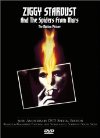Eye For Film >> Movies >> Ziggy Stardust And The Spiders From Mars (1973) Film Review
Ziggy Stardust And The Spiders From Mars
Reviewed by: Jennie Kermode

The first thing one notices about Ziggy Stardust And The Spiders From Mars today is the poster: a lush black and white image of David Bowie, who would go on to die from lung cancer, smoking a fatal cigarette. A pillar of fire shoots up from it, suggesting of the rocket engines glimpsed in so many of his songs. But that sad passing in January 2016 was not the first time David Bowie had died. Once he was embodied as a leper messiah and July the 3rd, 1973 was the night that the kids killed the man.
Indisputably one of the greatest concert films ever made, DA Pennebaker's striking work captures those last moments onstage in all their glory. Always hinting at what was to come and yet always innovating. Bowie had commissioned new clothes for the occasion and Freddie Buretti and Kansai's designs still look fresh today, but it's the way they're worn, the energy and sensuality with which the performer carries himself, that really makes an impact. (Mick Ronson, dolled up in silver and thrusting his groin at the camera, doesn't come off quite as well.) Backstage footage makes Bowie's consciousness of the performance unmistakable,but on stage he's as absorbed as any actor, becoming Ziggy, a projection of the desires of a hungry audience.

The backstage footage is gorgeously different, with its stained white walls, cheap plastic chairs, the reality of the average dressing room very different from the myth. Here Bowie is utterly down to Earth, talking and laughing with assistants and friends. Nobody pays the least attention to the camera and one really gets the sense that Pennebaker has captured them off guard, though of course, with Bowie, one could never be sure. The busy work, the tight organisation, and the casual humour that goes alongside it reveal a world that is commonplace in rock n' roll but that relatively few viewers will be familiar with. It's this mundanity that really gives the onstage action its edge, reminding us of the quieter worlds from which most of those in the audience have come, inviting us to connect with what this means to them.
As Ziggy, Bowie was perhaps at the height of his powers. His work would grow more sophisticated and there were many fascinating changes to come, but the sheer number of stonking tunes he put together at this time finds few comparisons in music history. All the audience favourites are here, from his signature tune to Suffragette City, Wild Eyed Boy From Freecloud and Rock N' Roll Suicide. They're delivered with real vigour and are thrilling to watch, holding the viewer all the way to the end.
The film has been criticised for the rough quality of some of the footage, but this gives it a vérité quality which distinguishes the real from the legend. It has an immediacy that keeps the film relevant to changing audiences and the grainy visuals help to conjure up the experience of being at a gig in that era, when the air was full of smoke and evaporating sweat. This may not be everybody's idea of a good time, but rock n' roll in the raw was never suited to those with delicate sensibilities. For all its mythologising, Ziggy Stardust And The Spiders From Mars tells it the way it was.
Reviewed on: 06 Feb 2016
















